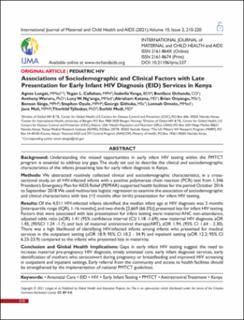| dc.contributor.author | Langat, Agnes | |
| dc.contributor.author | Callahan, Tegan L | |
| dc.contributor.author | Yonga, Isabella | |
| dc.contributor.author | Ochanda, Boniface | |
| dc.contributor.author | Waruru, Anthony | |
| dc.contributor.author | Ng'anga, Lucy W | |
| dc.contributor.author | Katana, Abraham | |
| dc.contributor.author | Onyango, Brian | |
| dc.contributor.author | Singa, Benson | |
| dc.contributor.author | Oyule, Stephen | |
| dc.contributor.author | Githuka, George | |
| dc.contributor.author | Omoto, Lennah | |
| dc.contributor.author | Muli, Jane | |
| dc.contributor.author | Tylleskär, Thorkild | |
| dc.contributor.author | Modi, Surbhi | |
| dc.date.accessioned | 2022-01-27T13:14:24Z | |
| dc.date.available | 2022-01-27T13:14:24Z | |
| dc.date.created | 2022-01-24T13:27:56Z | |
| dc.date.issued | 2021 | |
| dc.identifier.issn | 2161-8674 | |
| dc.identifier.uri | https://hdl.handle.net/11250/2890013 | |
| dc.description.abstract | Background: Understanding the missed opportunities in early infant HIV testing within the PMTCT program is essential to address any gaps. The study set out to describe the clinical and sociodemographic characteristics of the infants presenting late for early infant diagnosis in Kenya.
Methods: We abstracted routinely collected clinical and sociodemographic characteristics, in a cross-sectional study, on all HIV-infected infants with a positive polymerase chain reaction (PCR) test from 1,346 President’s Emergency Plan for AIDS Relief (PEPFAR) supported health facilities for the period October 2016 to September 2018. We used multivariate logistic regression to examine the association of sociodemographic and clinical characteristics with late (>2 months after birth) presentation for infant HIV testing.
Results: Of the 4,011 HIV-infected infants identified, the median infant age at HIV diagnosis was 3 months [interquartile range (IQR), 1-16 months], and two-thirds [2,669 (66.5%)] presented late for infant HIV testing. Factors that were associated with late presentation for infant testing were: maternal ANC non-attendance, adjusted odds ratio (aOR) 1.41 (95% confidence interval (CI) 1.18 -1.69); new maternal HIV diagnosis, aOR 1.45, (95%CI 1.24 -1.7); and lack of maternal antiretroviral therapy(ART), aOR 1.94, (95% CI 1.64 - 2.30). There was a high likelihood of identifying HIV-infected infants among infants who presented for medical services in the outpatient setting (aOR 18.9; 95% CI 10.2 - 34.9) and inpatient setting (aOR 12.2; 95% CI 6.23-23.9) compared to the infants who presented late in maternity.
Conclusion and Global Health Implications: Gaps in early infant HIV testing suggest the need to increase maternal pre-pregnancy HIV diagnosis, timely antenatal care, early infant diagnosis services, early identification of mothers who seroconvert during pregnancy or breastfeeding and improved HIV screening in outpatient and inpatient settings. Early referral from the community and access to health facilities should be strengthened by the implementation of national PMTCT guidelines. | en_US |
| dc.language.iso | eng | en_US |
| dc.publisher | Global Health and Education Projects, Inc. | en_US |
| dc.rights | Navngivelse 4.0 Internasjonal | * |
| dc.rights.uri | http://creativecommons.org/licenses/by/4.0/deed.no | * |
| dc.title | Associations of Sociodemographic and Clinical Factors with Late Presentation for Early Infant HIV Diagnosis (EID) Services in Kenya | en_US |
| dc.type | Journal article | en_US |
| dc.type | Peer reviewed | en_US |
| dc.description.version | publishedVersion | en_US |
| dc.rights.holder | Copyright 2021 Langat et al. | en_US |
| cristin.ispublished | true | |
| cristin.fulltext | original | |
| cristin.qualitycode | 1 | |
| dc.identifier.doi | 10.21106/ijma.537 | |
| dc.identifier.cristin | 1988569 | |
| dc.source.journal | International Journal of MCH and AIDS | en_US |
| dc.source.pagenumber | 210-220 | en_US |
| dc.identifier.citation | International Journal of MCH and AIDS. 2021, 10 (2), 210-220. | en_US |
| dc.source.volume | 10 | en_US |
| dc.source.issue | 2 | en_US |

